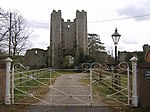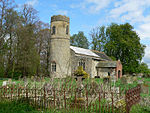Wangford Rural District
Districts of England created by the Local Government Act 1894History of SuffolkRural districts of EnglandUse British English from July 2017Waveney District

Wangford Rural District was a rural district within the administrative county of East Suffolk between 1894 and 1934. It was created out of the earlier Wangford rural sanitary district. It was named after the historic hundred of Wangford, whose boundaries it closely matched. It contained the group of small villages collectively known as The Saints. In 1910 a new urban district of Bungay was created out of a part of the northern side of the district. In 1934, under a County Review Order, Wangford Rural District was abolished and its parishes transferred to the new Wainford Rural District. In 1974 the area became part of Waveney district.
Excerpt from the Wikipedia article Wangford Rural District (License: CC BY-SA 3.0, Authors, Images).Wangford Rural District
Stone Street, East Suffolk
Geographical coordinates (GPS) Address Nearby Places Show on map
Geographical coordinates (GPS)
| Latitude | Longitude |
|---|---|
| N 52.43 ° | E 1.47 ° |
Address
Stone Street
Stone Street
NR34 8JG East Suffolk
England, United Kingdom
Open on Google Maps








